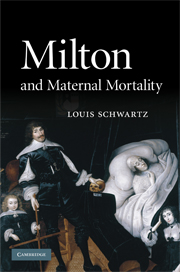Book contents
- Frontmatter
- Contents
- Acknowledgments
- Abbreviations
- Introduction
- PART I BEHIND THE VEIL: CHILDBIRTH AND THE NATURE OF OBSTETRIC ANXIETY IN EARLY MODERN ENGLAND
- PART II “SCARCE-WELL-LIGHTED FLAME”: THE REPRESENTATION OF MATERNAL MORTALITY IN MILTON'S EARLY POETRY
- PART III “CONSCIOUS TERROURS”: THE PROBLEM OF MATERNAL MORTALITY IN MILTON'S LATER POETRY
- 7 The wide wound and the veil: Sonnet 23 and the “birth” of Eve in Paradise Lost
- 8 “Conscious terrours” and “the Promis'd Seed”: seventeenth-century obstetrics and the allegory of Sin and Death in Paradise Lost
- 9 The “womb of waters” and the “abortive gulph”: on the reproductive imagery of Milton's cosmos
- Index
- References
8 - “Conscious terrours” and “the Promis'd Seed”: seventeenth-century obstetrics and the allegory of Sin and Death in Paradise Lost
Published online by Cambridge University Press: 04 December 2009
- Frontmatter
- Contents
- Acknowledgments
- Abbreviations
- Introduction
- PART I BEHIND THE VEIL: CHILDBIRTH AND THE NATURE OF OBSTETRIC ANXIETY IN EARLY MODERN ENGLAND
- PART II “SCARCE-WELL-LIGHTED FLAME”: THE REPRESENTATION OF MATERNAL MORTALITY IN MILTON'S EARLY POETRY
- PART III “CONSCIOUS TERROURS”: THE PROBLEM OF MATERNAL MORTALITY IN MILTON'S LATER POETRY
- 7 The wide wound and the veil: Sonnet 23 and the “birth” of Eve in Paradise Lost
- 8 “Conscious terrours” and “the Promis'd Seed”: seventeenth-century obstetrics and the allegory of Sin and Death in Paradise Lost
- 9 The “womb of waters” and the “abortive gulph”: on the reproductive imagery of Milton's cosmos
- Index
- References
Summary
The nature and function of the allegory of Sin and Death has been a bone of contention in Milton criticism as far back as the eighteenth century, when Addison and Johnson criticized it as a failure of decorum. Most critics today accept the allegory, along with the other allegorical episodes in the poem, as appropriate and significant parts of its structure. However, there is still a good deal of argument about what the allegory signifies, and why Milton used the mode at all in an otherwise naturalistic epic. As a result of these debates, a rich critical literature has accumulated. The various permutations of the relationships between Milton's figures have been worked out, and a large number of sources, analogues, and allusions have been uncovered and interpreted. My purpose in this chapter, however, is to suggest that, because few critics have paid much attention to the naturalistic elements of Milton's allegory, an allegory that deftly and somewhat strangely mixes modes, an important aspect of the way it presents itself to readers, has been ignored.
Few critics have noted, for example, that Milton not only goes out of his way to present us with terrifying and grotesque figures of childbirth, going well beyond the suggestions of birth he found in his sources, but that in constructing these figures, he drew on contemporary obstetric experience and practice.
- Type
- Chapter
- Information
- Milton and Maternal Mortality , pp. 211 - 244Publisher: Cambridge University PressPrint publication year: 2009



